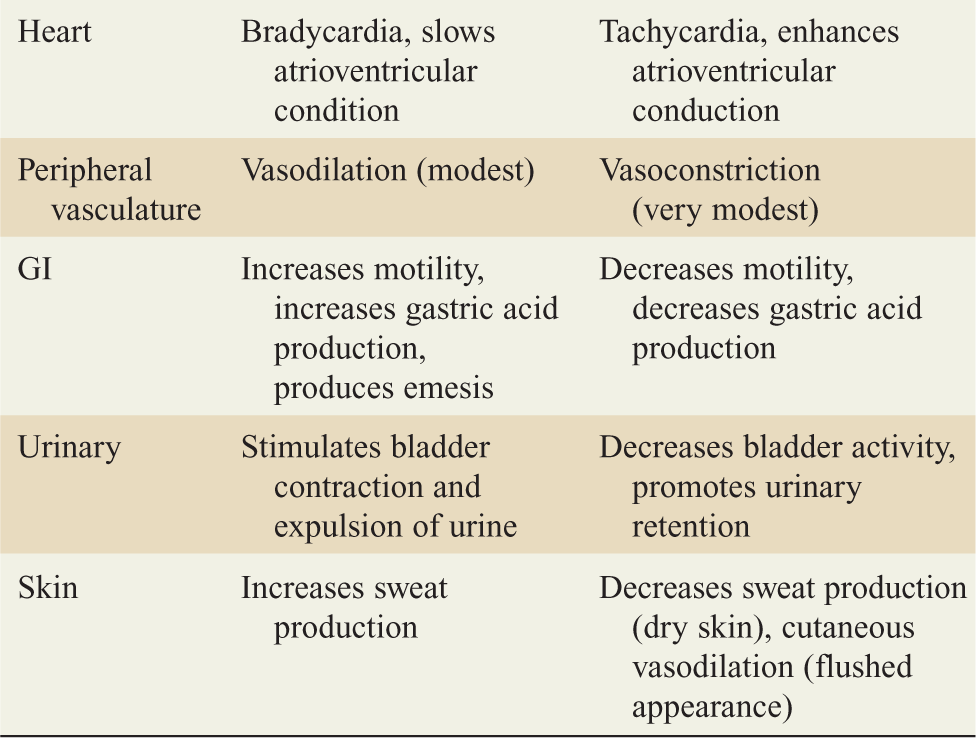Anticholinergic toxicity is encountered because of the common use of phenothiazines, mydriatics, skeletal muscle relaxants, antihistamines (particularly diphenhydramine), antidepressants, antispasmotics, and antiparkinsonian drugs.
![]() Jimsonweed is a plant associated with anticholinergic toxicity.
Jimsonweed is a plant associated with anticholinergic toxicity.
PATHOPHYSIOLOGY
![]() The mechanism of action involves cholinergic blockade of muscarinic receptors (primarily in the brain), nicotinic receptors, or both. The clinical effects of these agents result from disturbances in the parasym-pathetic nervous system (peripheral effects) and the brain (central effects).
The mechanism of action involves cholinergic blockade of muscarinic receptors (primarily in the brain), nicotinic receptors, or both. The clinical effects of these agents result from disturbances in the parasym-pathetic nervous system (peripheral effects) and the brain (central effects).
![]() Drug absorption can occur after ingestion, smoking, or ocular use.
Drug absorption can occur after ingestion, smoking, or ocular use.
![]() Table 103-1 describes muscarinic and antimuscarinic effects.
Table 103-1 describes muscarinic and antimuscarinic effects.
TABLE 103-1 Muscarinic and Antimuscarinic Effects


CLINICAL EFFECTS
![]() Clinical findings include mydriasis, hypoactive or absent bowel sounds, tachycardia, flushed skin, disorientation, urinary retention, hyperthermia, dry skin and mucus membranes, dysarthria, confusion, agitation, and auditory or visual hallucinations.
Clinical findings include mydriasis, hypoactive or absent bowel sounds, tachycardia, flushed skin, disorientation, urinary retention, hyperthermia, dry skin and mucus membranes, dysarthria, confusion, agitation, and auditory or visual hallucinations.
![]() Clinical findings can be remembered as: Dry as a Bone, Red as a Beet, Hot as a Hare, Blind as a Bat, Mad as a Hatter, and Stuffed as a Pipe.
Clinical findings can be remembered as: Dry as a Bone, Red as a Beet, Hot as a Hare, Blind as a Bat, Mad as a Hatter, and Stuffed as a Pipe.
![]() The most common ECG finding is sinus tachycardia. Wide-complex tachydysrhythmias and QT-interval prolongation can also be seen.
The most common ECG finding is sinus tachycardia. Wide-complex tachydysrhythmias and QT-interval prolongation can also be seen.
DIAGNOSIS AND DIFFERENTIAL
![]() Diagnosis is primarily clinical. In isolated anticholinergic toxicity, routine laboratory studies should be normal. Nonetheless, obtain electrolytes, glucose level, toxicology screening, and pulse oximetry in the presence of altered mental status.
Diagnosis is primarily clinical. In isolated anticholinergic toxicity, routine laboratory studies should be normal. Nonetheless, obtain electrolytes, glucose level, toxicology screening, and pulse oximetry in the presence of altered mental status.
![]() In contrast, sympathomimetic toxicity and delirium tremens present with moist skin and active bowel sounds. Acute psychiatric disorders may have tachycardia and tachypnea, but the physical examination is otherwise unremarkable.
In contrast, sympathomimetic toxicity and delirium tremens present with moist skin and active bowel sounds. Acute psychiatric disorders may have tachycardia and tachypnea, but the physical examination is otherwise unremarkable.
![]() The differential diagnosis includes viral encephalitis, Reye’s syndrome, head trauma, other intoxications, neuroleptic malignant syndrome, alcohol withdrawal, delirium tremens, acute psychiatric disorders, and sympathomimetic toxicity.
The differential diagnosis includes viral encephalitis, Reye’s syndrome, head trauma, other intoxications, neuroleptic malignant syndrome, alcohol withdrawal, delirium tremens, acute psychiatric disorders, and sympathomimetic toxicity.
EMERGENCY DEPARTMENT CARE AND DISPOSITION
![]() Treatment is primarily supportive. Place the patient on a cardiac monitor and secure intravenous access.
Treatment is primarily supportive. Place the patient on a cardiac monitor and secure intravenous access.
![]() GI decontamination with activated charcoal may be useful even outside the 1-hour window of ingestion because of diminished GI motility.
GI decontamination with activated charcoal may be useful even outside the 1-hour window of ingestion because of diminished GI motility.
![]() Treat hyperthermia and seizures with conventional measures.
Treat hyperthermia and seizures with conventional measures.
![]() Standard antiarrhythmics are usually effective, but class la medications should be avoided. Treat wide complex tachydysrhythmias with intravenous sodium bicarbonate.
Standard antiarrhythmics are usually effective, but class la medications should be avoided. Treat wide complex tachydysrhythmias with intravenous sodium bicarbonate.
![]() Treat agitation with benzodiazepines, such as lorazepam. Phenothiazines should be avoided.
Treat agitation with benzodiazepines, such as lorazepam. Phenothiazines should be avoided.
![]() Physostigmine treatment is controversial. Consider its use if conventional therapy fails to control agitation and delirium. The initial dose is 0.5 to 2 milligrams IV, administered slowly over 5 minutes. When effective, a significant decrease in agitation may be apparent within 15 to 20 minutes.
Physostigmine treatment is controversial. Consider its use if conventional therapy fails to control agitation and delirium. The initial dose is 0.5 to 2 milligrams IV, administered slowly over 5 minutes. When effective, a significant decrease in agitation may be apparent within 15 to 20 minutes.
![]() Physostigmine may lead to severe bradycardia and asystole. It is contraindicated in patients with asthma, intestinal or bladder obstruction, or heart block.
Physostigmine may lead to severe bradycardia and asystole. It is contraindicated in patients with asthma, intestinal or bladder obstruction, or heart block.
![]() Discharge patients with mild anticholinergic toxicity after 6 hours of observation if their symptoms have resolved. Admit more symptomatic patients for 24 hours of observation. Patients receiving physostigmine usually require at least a 24-hour admission.
Discharge patients with mild anticholinergic toxicity after 6 hours of observation if their symptoms have resolved. Admit more symptomatic patients for 24 hours of observation. Patients receiving physostigmine usually require at least a 24-hour admission.
Stay updated, free articles. Join our Telegram channel

Full access? Get Clinical Tree



